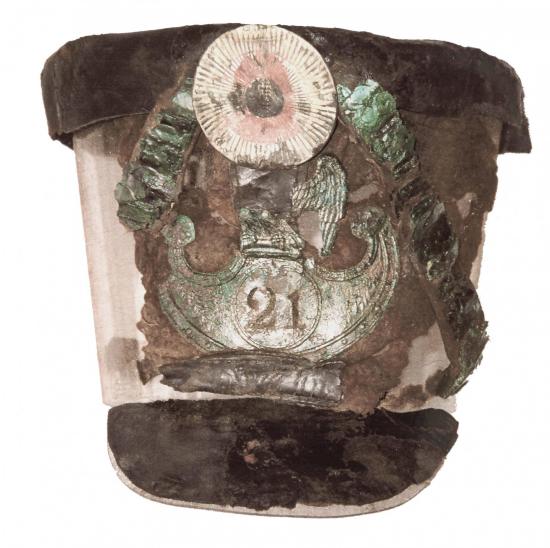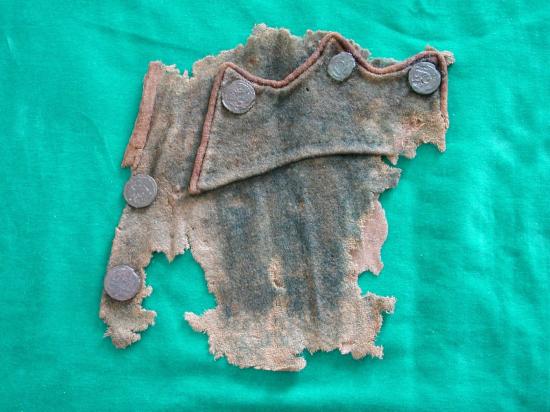PART.2
Napoleon’s men were not in good health, even before their ill-fated stop in Vilnius. Research on the teeth of the soldiers in the mass grave showed rampant dental cavities and indications of stress during childhood, and over one-quarter of the dead had likely succumbed to epidemic typhus, a louse-borne disease. A febrile illness like typhus could cause increased loss of body water through urine, sweat, and diarrhea, which may also cause a rise in nitrogen isotopes. And, of course, historical accounts detail how troops fruitlessly scoured the countryside for food and how many of them ate their dead or dying horses.
 Military dress hat, found in the Napoleonic mass grave in Vilnius. (Image used with kind permission of Rimantas Jankauskas)
Military dress hat, found in the Napoleonic mass grave in Vilnius. (Image used with kind permission of Rimantas Jankauskas)
 Fragment of a pocket of a soldier’s uniform, with regimental buttons, from the mass grave of 1812 in Vilnius. (Image used with kind permission of Rimantas Jankauskas)
Fragment of a pocket of a soldier’s uniform, with regimental buttons, from the mass grave of 1812 in Vilnius. (Image used with kind permission of Rimantas Jankauskas)
What caused the high nitrogen values among the Grande Armée? It could be the result of consumption of marine resources, from pathological conditions, or from starvation – or even from a combination of these. While the soldiers were not getting seafood from frozen Vilnius, I wondered about preserved fish and asked historian Max Owre, executive director of humanities at the University of North Carolina at Chapel Hill, about the provisioning of the army. “There was no large scale tinning of goods,” Owre says, which means that “it’s possible that soldiers could have carried saltied, dried cod, but more likely they were simply starving.” The carbon isotope values also help rule out seafood consumption, as they are more negative than the typical range for marine-based diets. This leaves illness or lack of food.
“The prolonged periods of starvation possibly stem from career-long military service in numerous campaigns throughout the Napoleonic Wars,” Holder writes, “or from nutritional stresses prior to military conscription.” Although she admits she cannot say definitively what the cause of the elevated nitrogen values was, Holder notes that, given all the available evidence from historical records and previous studies, the “nitrogen enrichment is most likely the result of prolonged nutritional stress.”
Both Pelier and Holder tested the bones of women as well as men. But why would there have been women in a mass grave of Napoleonic soldiers? Owre told me that “there were plenty of camp followers as well as official woman cantinières and vivandières who sold goods to the troops. This woman from southern France would likely have been one of these or a follower. Some wives did tag along.” Finding the remains of women in this mass grave means archaeologists can add to the historical record, which largely glosses over women’s experiences in this war.
Studies of the bones of Napoleon’s soldiers are key evidence in finding out what really happened in the Russian Campaign. Owre tells me that a large amount of pro-Napoleon scholarship places the blame for massive troop death on the cold Russian winter. But, he points out, “military logistics at the time were incapable of supporting an army this size, even considering that living off the land—stealing from locals—was the modus operandi of Napoleon’s armies and his enemies by this point.” If Holder is right that the elevated nitrogen signatures represent starvation, this “would be another piece of evidence for the failure of the Russian campaign,” Owre concludes.
The members of Napoleon’s Grande Armée who perished in Vilnius in the winter of 1812 are now in a new burial location: the Antakalnis Military Cemetery, where they rest with other war heroes. Bone samples that have been preserved, however, may yet yield additional information about the short lives and tragic deaths of these young men and women.
To read more about this mass grave and the biochemical analyses of the skeletons, see: Pelier, S.M. 2015. Stable isotope evidence for the geographic origins and military movement of Napoleonic soldiers during the march from Moscow in 1812. Holder, S. 2013. Interpreting diet and nutritional stress in Napoleon’s Grand Army using stable carbon and nitrogen isotope analysis. Signoli, M. et al. 2004. Discovery of a mass grave of Napoleonic period in Lithuania (1812, Vilnius). C. R. Palevol 3:219-227.